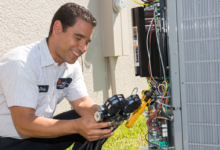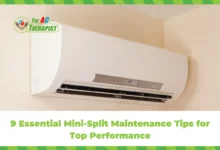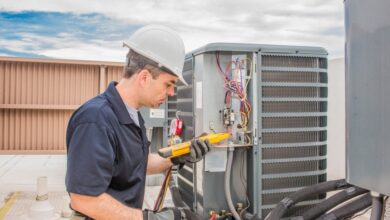Basic AC Maintenance: A Comprehensive Guide to Keep Your Unit Running Efficiently
Sponsored Ads
As the summer months approach, it’s essential to ensure your air conditioner (AC) is ready to keep you cool and comfortable during the hot weather. Regular AC maintenance is crucial for optimal performance, energy efficiency, and extended lifespan of your unit. In this comprehensive guide, we will delve into the basics of AC maintenance, providing step-by-step instructions, explaining the benefits, and addressing common concerns to empower you with the knowledge to maintain your AC like a pro.
Introduction: The Importance of AC Maintenance
AC maintenance is often overlooked, but it plays a vital role in ensuring your unit operates at peak efficiency. By performing regular maintenance, you can:
- Enhance energy efficiency, saving you money on utility bills.
- Extend the lifespan of your AC unit, reducing the need for costly repairs or replacements.
- Improve indoor air quality by removing dust, pollen, and other allergens.
- Reduce the risk of breakdowns during peak usage periods.
- Maintain warranty coverage, as many manufacturers require regular maintenance.
Investing in AC maintenance is a wise decision that will pay dividends in the long run. By following these simple steps, you can ensure your AC unit provides you with years of reliable and efficient cooling.
Strengths and Weaknesses of Basic AC Maintenance
Every task has its strengths and weaknesses, and basic AC maintenance is no exception. Here’s a detailed analysis:
Strengths
- Ease of implementation: Basic AC maintenance tasks are straightforward and can be performed by homeowners with minimal technical skills.
- Affordability: The cost of basic AC maintenance is typically low, especially compared to the potential expenses associated with repairs or premature failure.
- Improved performance: Regular maintenance helps keep your AC unit operating at peak efficiency, providing optimal cooling and energy savings.
Weaknesses
- Limited scope: Basic AC maintenance covers only routine tasks and does not address complex issues that may require professional attention.
- Frequency: Basic AC maintenance should be performed regularly, typically every spring and fall, which can be time-consuming for busy homeowners.
- Potential for errors: If not performed correctly, basic AC maintenance tasks could inadvertently cause damage to your unit.
By weighing the strengths and weaknesses carefully, you can make an informed decision about whether basic AC maintenance is the right choice for you.
Comprehensive Guide to Basic AC Maintenance
Performing basic AC maintenance is relatively simple and straightforward. Here’s a comprehensive guide to help you get started:
1. Change the Air Filter Regularly
The air filter is one of the most important components of your AC unit. It traps dust, pollen, and other allergens, preventing them from circulating through your home. A dirty air filter can restrict airflow, reducing cooling efficiency and potentially causing damage to your unit. It’s recommended to change the air filter every month during peak usage periods, especially during the summer months.
2. Clean the Condenser Coils
The condenser coils are located on the outside unit of your AC system. They release heat from the refrigerant, allowing your unit to cool your home. Over time, the coils can become clogged with dirt, dust, and debris, reducing their ability to dissipate heat. Clean the condenser coils at least once a year, especially before the start of the cooling season.
3. Check the Refrigerant Levels
Refrigerant is the lifeblood of your AC system. It circulates through the coils, absorbing heat from your home and releasing it outside. Low refrigerant levels can significantly impact cooling performance and cause premature compressor failure. Check the refrigerant levels annually to ensure they are at the optimal level.
4. Lubricate Moving Parts
Your AC unit consists of several moving parts, including the compressor, fan motor, and blower motor. These parts require regular lubrication to reduce friction and wear. Use a high-quality AC lubricant to lubricate these parts annually.
5. Inspect the Electrical Connections
Loose or damaged electrical connections can lead to electrical problems, reduced cooling performance, and even safety hazards. Inspect all electrical connections annually, especially the wires connecting the indoor and outdoor units. Tighten any loose connections and replace damaged wires.
6. Clean the Drain Line
The drain line is responsible for removing condensation from your AC unit. A clogged drain line can lead to water leakage, damage to your unit, and mold growth. Clean the drain line annually to ensure it is free of debris.
7. Inspect the Thermostat
The thermostat is the control center of your AC system. It measures the temperature inside your home and sends signals to the unit to turn on or off. A faulty thermostat can lead to inconsistent cooling, energy waste, and premature unit failure. Inspect the thermostat annually, replace the batteries if necessary, and ensure it is properly calibrated.
Additional AC Maintenance Tips
In addition to the basic maintenance tasks outlined above, here are some additional tips to keep your AC unit running smoothly:
- Keep the area around your outdoor unit clear of debris, such as leaves, grass, and overgrown vegetation.
- Avoid using harsh chemicals or abrasive cleaners on your AC unit.
- If you notice any unusual noises, vibrations, or leaks, contact a qualified HVAC technician immediately.
- Consider scheduling regular professional AC maintenance for a comprehensive inspection and tune-up.
- Register your AC unit with the manufacturer to receive warranty coverage and technical support.
Frequently Asked Questions (FAQs)
How often should I perform basic AC maintenance?
It is recommended to perform basic AC maintenance twice a year, once in the spring before the start of the cooling season and again in the fall before the start of the heating season.
Can I perform basic AC maintenance myself?
Yes, basic AC maintenance tasks are relatively simple and can be performed by homeowners with minimal technical skills. However, if you are not comfortable performing these tasks, it is advisable to contact a qualified HVAC technician.
What tools do I need for basic AC maintenance?
The tools required for basic AC maintenance include a screwdriver, a wrench, a pair of pliers, a wet/dry vacuum cleaner, and a hose.
Is it safe to perform basic AC maintenance myself?
Yes, it is safe to perform basic AC maintenance yourself as long as you take appropriate safety precautions, such as wearing gloves and safety glasses. However, if you are not comfortable performing these tasks, it is advisable to contact a qualified HVAC technician.
What are the signs that my AC unit needs professional maintenance?
Signs that your AC unit needs professional maintenance include:
- Reduced cooling capacity
- Increased energy consumption










